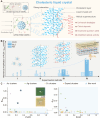Maximized circularly polarized luminescence from metal clusters accelerates chiral photopolymerization
- PMID: 40715148
- PMCID: PMC12297583
- DOI: 10.1038/s41467-025-62232-9
Maximized circularly polarized luminescence from metal clusters accelerates chiral photopolymerization
Abstract
The practical application of the circularly polarized luminescence (CPL) emitted from chiral substances faces significant hurdles, primarily due to the small luminescence dissymmetry factor (glum) and low photoluminescence quantum yield (PLQY). Herein, we demonstrate a hierarchical system in which metal clusters exhibit excellent CPL performance, with both excellent glum factors and high PLQYs, thereby triggering enantioselective photopolymerization. Their CPL activities are sequentially amplified in different assembly forms induced by liquid crystals (LCs), and the maximum glum factor is increased by 1240 times, reaching a value of 1.24. The PLQYs of the metal clusters in different assembled states are sharply enhanced compared to that in the discrete state. Benefiting from the CPL performance of the metal clusters, their CPL was used to remotely regulate enantioselective polymerization, thus realizing light-to-matter chirality transfer. Impressively, upon incorporation of achiral luminophores, the polymer system is endowed with CPL through sequential chirality transfer. These innovative achievements open new avenues for the design and cutting-edge application of CPL-active metal clusters.
© 2025. The Author(s).
Conflict of interest statement
Competing interests: The authors declare no competing interests.
Figures






Similar articles
-
Solvent Modulation of Chiral Perovskite Films Enables High Circularly Polarized Luminescence Performance from Chiral Perovskite/Quantum Dot Composites.ACS Appl Mater Interfaces. 2023 Feb 22;15(7):9978-9986. doi: 10.1021/acsami.2c20716. Epub 2023 Feb 8. ACS Appl Mater Interfaces. 2023. PMID: 36753711
-
Assembling Octahedral Pt2Ag4 Clusters for High-Efficiency Circularly Polarized Luminescence.Adv Mater. 2025 Jul;37(27):e2502899. doi: 10.1002/adma.202502899. Epub 2025 May 6. Adv Mater. 2025. PMID: 40326214
-
Tunable Circularly Polarized Luminescence Through Chiral Dopant Dihedral Angle Modulation in Liquid Crystal Polymer Films.Small. 2025 Sep;21(35):e2505269. doi: 10.1002/smll.202505269. Epub 2025 Jul 9. Small. 2025. PMID: 40630006
-
Advances in chiral luminescent liquid crystals (CLLCs): from molecular design to applications.Mater Horiz. 2025 Jul 28;12(15):5627-5653. doi: 10.1039/d4mh01928h. Mater Horiz. 2025. PMID: 40341900 Review.
-
Recent Advances in Liquid Crystal Polymer-Based Circularly Polarized Luminescent Materials: A Review.Polymers (Basel). 2025 Jul 17;17(14):1961. doi: 10.3390/polym17141961. Polymers (Basel). 2025. PMID: 40732840 Free PMC article. Review.
References
-
- Li, Y. et al. Double-helical assembly of heterodimeric nanoclusters into supercrystals. Nature594, 380–384 (2021). - PubMed
-
- Zhu, Y., Guo, J., Qiu, X., Zhao, S. & Tang, Z. Optical activity of chiral metal nanoclusters. Acc. Mater. Res.2, 21–35 (2020).
-
- Shi, L. et al. Self-assembly of chiral gold clusters into crystalline nanocubes of exceptional optical activity. Angew. Chem. Int. Ed.56, 15397–15401 (2017). - PubMed
-
- Zhan, X. et al. 3D laser displays based on circularly polarized lasing from cholesteric liquid crystal arrays. Adv. Mater.33, 2104418 (2021). - PubMed
LinkOut - more resources
Full Text Sources
Miscellaneous

